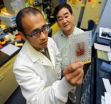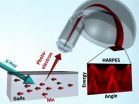(Press-News.org) This press release is available in Spanish.
This line of research, coordinated by Luz Neira, who is a professor in the Department of Humanities: History, Geography and Art, as well as a researcher in UC3M's Institute for Culture and Technology (Instituto de Cultura y Tecnología), continues on the path established by previous studies that examined the images of women and certain legends in Roman mosaics. "We had previously shown the memory and conscious, self-interested reuse of myths, but this new volume also examines the possibility that there is a subliminal message regarding the elites' fundamental concept of the civilization versus barbarism binomial," explains the historian, who was in charge of the coordination and publication of 'Civilización y barbarie: el mito como argumento en los mosaicos romanos' ('Civilization and Barbarism: Myths as plots in Roman Mosaics') (CVG, 2012). A variety of specialists in Roman mosaics also collaborated on this book, which offers a new perspective in the approach to mythology and its reuse throughout history, which was a result of "a conscious and self-interested phenomenon of re-semantization."
Specifically, there are premeditated and conscious recreations of certain mythological characters and episodes from different areas of the Empire, which were selected and even distorted in order to generate a spirit, deepen principles, or recall the foundations upon which their privileged position within the Roman state had been established, the researchers explain. "They re-used certain Greek myths as symbols that reinforced what Rome stood for," states Luz Neira, "because they were of transcendental importance, due to the universal values they depicted, and they became champions of civilization".
The scene of Achilles in Skyros, one of the most frequently depicted among the mosaics of the imperial epoch and which can be found, for example, in the villa of La Olmeda (Palencia), seems to be intended to highlight the archetype of the hero who is capable of giving his life for his country. The legends of divinities such as Dionysius and Aphrodite, the Labors of Hercules, the Journeys of Perseus and the battles between Amazons and centaurs are some of the other mythological episodes that originated in Greece that the Romans appropriated as their own and converted into models to be followed. "The memory of a legendary war and a mythological hero would become with the passing of time, and even up to the present day, the phenomenon with the greatest impact on people and individuals; this is what led us to analyze the myth as the story of the struggle between civilization and barbarism," concludes the researcher.
Historiography in mosaics
Until now, the concept of the civilization in the Roman Empire had been analyzed using written sources and official images found in public spaces, in sculptures or relieves of certain monuments, such as arcs, steles or commemorative columns. However, very little in-depth research had been done on the representation of these concepts in private spaces, perhaps due to their domestic character, the researchers point out. "We were surprised by the absence of references of this type in the form of mosaics, where due to their unusual circumstances of conservation in situ the mosaic documentation offers an authentic repertoire of tile work, with geometric, plant and human figure decoration, connected to the private domestic contexts that pertained to the most privileged sectors of Roman society in any urban or rural location of the Empire," comments Professor Neira.
In this respect, according to this historian, it seemed unthinkable, a priori, that members of the elite, who were involved in the government and matters of the Empire, would not have made use of the significant surface area of the mosaics that paved the living spaces of their domus and villae to commemorate their victories and their identification with Rome as a guarantor of civilization as opposed to "barbarism". "They did it," states Luz Neira, "by depicting re-used myths that evoked the values that, from an ideological point of view, Rome wished to represent."
###
Caption under image:
Achilles in Skyros de Zeugma, mosaic preserved in the Museum of Gaziantep (Turkey). Photo: Luz Neira
The Romans used Greek myths in their mosaics as symbols of civilization
2012-10-15
ELSE PRESS RELEASES FROM THIS DATE:
Protein could be key for drugs that promote bone growth
2012-10-15
AUGUSTA, Ga. – Georgia Health Sciences University researchers have developed a mouse that errs on the side of making bone rather than fat, which could eventually lead to better drugs to treat inflammatory diseases such as rheumatoid arthritis.
Drugs commonly used to treat those types of conditions – called glucocorticoids – work by turning down the body's anti-inflammatory response, but simultaneously turn on other pathways that lead to bone loss. The result can lead to osteoporosis and an accumulation of marrow fat, says Dr. Xingming Shi, bone biologist at the GHSU ...
Antibiotic contamination a threat to humans and the environment
2012-10-15
Researchers from the University of Gothenburg, Sweden, spend August in Sisimiut on the west coast of Greenland studying the prevalence of antibiotic resistance and the effects of antibiotic emissions on communities of bacteria living in marine sediments. More specifically, they were investigating how communities of bacteria in sediment and clay on the seabed are affected by exposure to antibiotics.
"We know very little about what happens to antibiotics that end up in the ocean, but several substances can accumulate in sediments where biodegradation occurs extremely slowly," ...
U-M, other universities launch Great Lakes protection project
2012-10-15
ANN ARBOR—The University of Michigan and 20 other U.S. and Canadian universities will join forces to propose a set of long-term research and policy priorities to help protect and restore the Great Lakes and to train the next generation of scientists, attorneys, planners and policy specialists who will study them.
The Great Lakes Futures Project of the Transborder Research University Network will use a cross-disciplinary, cross-sector approach to outlining alternative Great Lakes futures through science-based scenario analysis.
"With the recent release of the revised ...
Space station and space flight gravity influence immune system development
2012-10-15
New research findings recently published in The FASEB Journal, show that immune system development is affected by gravity changes, as reported by researchers from the University of Lorraine and University of Luxembourg. Astronauts are exposed to stresses, during launch and landing, which disrupts their body's natural defenses against infection. Changes to the immune system need to be investigated before astronauts undergo longer space missions.
Researchers looked at how antibody production is affected when animal development occurs onboard a space station and which ...
DNA method can provide more effective treatment of childhood cancer
2012-10-15
After leukaemia and brain tumours, neuroblastoma is the most common form of cancer to affect children. A thesis from the Sahlgrenska Academy, University of Gothenburg, Sweden, has studied a DNA method which is now used for all cases of neuroblastoma in Sweden, and which has led to more effective treatment at individual level.
Neuroblastoma affects around 20 children each year, most of them under the age of two. This form of cancer, which affects the peripheral nervous system, is particularly unusual: some tumours can regress spontaneously without treatment, while others ...
The tomboy in manga for teens: Kaleidoscopic bodily styles
2012-10-15
Ylva Sommerland, from the University of Gothenburg, Sweden, has studied the tomboy in manga, a girl manoeuvring in masculine situations. The study concerns sports manga and fantasy manga for teens – genres that offer plenty of tomboy stories.
The study focuses on a tomboy found in Mitsuru Adachi's sports manga Cross Game. Sports manga is immensely popular in Japan, and Mitsuru Adachi is one of the most well-known artists in this genre. He has been active since the 1970s.
"My analyses for example show that his character Aoba uses her entire female body when playing ...
Another advance on the road to spintronics
2012-10-15
Spintronic technology, in which data is processed on the basis of electron "spin" rather than charge, promises to revolutionize the computing industry with smaller, faster and more energy efficient data storage and processing. Materials drawing a lot of attention for spintronic applications are dilute magnetic semiconductors – normal semiconductors to which a small amount of magnetic atoms is added to make them ferromagnetic. Understanding the source of ferromagnetism in dilute magnetic semiconductors has been a major road-block impeding their further development and use ...
New merciful treatment method for children with brain tumors
2012-10-15
Children who undergo brain radiation therapy run a significant risk of suffering from permanent neurocognitive adverse effects. These adverse effects are due to the fact that the radiation often encounters healthy tissue. This reduces the formation of new cells, particularly in the hippocampus – the part of the brain involved in memory and learning.
Researchers at the University of Gothenburg's Sahlgrenska Academy have used a model study to test newer radiation therapy techniques which could reduce these harmful adverse effects. The researchers based their study on a ...
University of Tennessee collaborates in study: Dire drought ahead, may lead to massive tree death
2012-10-15
Evidence uncovered by a University of Tennessee, Knoxville, geography professor suggests recent droughts could be the new normal. This is especially bad news for our nation's forests.
For most, to find evidence that recent years' droughts have been record-breaking, they need not look past the withering garden or lawn. For Henri Grissino-Mayer he looks at the rings of trees over the past one thousand years. He can tell you that this drought is one of the worst in the last 600 years in America's Southwest and predicts worst are still to come.
Grissino-Mayer collaborated ...
NIH-funded study to test pneumococcal vaccine in older adults
2012-10-15
Researchers plan to see if a higher dose of a pneumococcal vaccine will create a stronger immune response in older adults who received an earlier generation vaccine against pneumonia and other pneumococcal diseases.
The study supported by the National Institutes of Health will compare two dosages of a pneumococcal vaccine approved for children ages 6 weeks to 5 years, and adults 50 and older. The trial will enroll up to 882 men and women ages 55 to 74.
The study is funded by the National Institute of Allergy and Infectious Diseases (NIAID), part of NIH. Researchers ...

